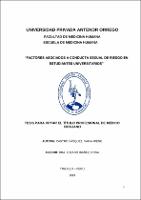| dc.contributor.advisor | Lozano Ibáñez, Rosa | |
| dc.contributor.author | Castro Vásquez, Vania Irene | |
| dc.creator | Castro Vásquez, Vania Irene | |
| dc.date.accessioned | 2019-08-26T15:56:30Z | |
| dc.date.available | 2019-08-26T15:56:30Z | |
| dc.date.issued | 2019 | |
| dc.identifier.uri | https://hdl.handle.net/20.500.12759/5327 | |
| dc.description.abstract | OBJETIVO: Determinar los factores que se asocian a conducta sexual de riesgo en universitarios de Medicina Humana de la Universidad Privada Antenor Orrego.
MATERIAL Y MÉTODO: Se realizó un estudio analítico, observacional de corte transversal, mediante una encuesta virtual con variables sociodemográficas y el Cuestionario Confidencial sobre Vida Sexual Activa (CCVSA) que consta de 27 ítems, los cuales reúnen preguntas relacionadas con la experiencia sexual, así como recaudan información sobre Infecciones de Transmisión Sexual. Este cuestionario fue entregado a través de un URL de Google Drive a los delegados de cada año académico, que se encargaron de compartir el link a sus compañeros. Se evaluó a los alumnos inscritos en el periodo 2019 – I, estos fueron 3204, de los cuales se encuesto a 825 (349 varones y 476 mujeres). Según el cálculo dado por el Sofware EpiInfo® nuestra muestra tuvo más del 99% de confianza. El análisis estadístico empleado fue la prueba t de student para variables cuantitativas y chi-cuadrado para las variables cualitativas.
RESULTADOS: El análisis de los 825 alumnos, 349 varones y 476 mujeres, identificó que 579 estudiantes presentaron conducta sexual de riesgo (70,18%), de estos 288 fueron hombres y 291 mujeres. La población sin conducta sexual de riesgo fue de 246; 61 varones y 185 féminas. El análisis bivariado halló que la edad entre 18 y 22 años, el género masculino, cursar ciencias básicas, vivir solo, consumir alcohol y fumar cigarrillos son factores asociados a conductas sexuales de riesgo. La probabilidad de presentar CSR aumenta en 3 veces para los varones, en 2 para los alumnos que viven solo; 7,17 para aquellos que ingieren bebidas alcohólicas y en 6,50 para los que fuman.
CONCLUSIONES:
La prevalencia de conducta sexual de riesgo en los estudiantes de Medicina Humana es de 70,18%. La edad, el género masculino, cursar ciencias básicas, vivir solo, consumir alcohol y fumar cigarrillos son factores asociados a conductas sexuales de riesgo. El Área bajo la Curva ROC determino que nuestro estudio es capaz de predecir la conducta sexual de riesgo. | es_PE |
| dc.description.abstract | OBJECTIVE: To determine the factors associated with risky sexual behavior in university of the Faculty of Human Medicine of the Antenor Orrego Private University.
MATERIAL AND METHOD: An analytical, observational, cross-sectional study was conducted through a virtual survey with sociodemographic variables and the Confidential Questionnaire on Active Sexual Life (CCVSA), which consists of 27 items, which gather questions related to sexual experience, as well as how they collect information about Sexually Transmitted Infections. This questionnaire was delivered through a Google Drive URL to the delegates of each academic year, who were in charge of sharing the link to their classmates. The students enrolled in the period 2019 - I were evaluated, these were 3204, of which 825 were tested (349 boys and 476 girls). According to the calculation given by the EpiInfo® Software, our sample had more than 99% confidence. The statistical analysis used was the student's t test for quantitative variables and chi-square for qualitative variables.
RESULTS: The analysis of the 825 students, 349 men and 476 women, identified that 579 students presented sexual risk behavior (70.18%), of these 288 were men and 291 women. The population without sexual risk behavior was 246; 61 males and 185 females. The bivariate analysis found that the age between 18 and 22 years, the male gender, studying basic sciences, living alone, consuming alcohol and smoking cigarettes are factors associated with risky sexual behavior. The probability of presenting CSR increases by 3 times for males, in 2 for students who live alone; 7.17 for those who drink alcoholic beverages and 6.50 for those who smoke.
CONCLUSIONS: The prevalence of risky sexual behavior in Human Medicine students is 70.18%. The age, the masculine gender, to study basic sciences, to live alone, to consume alcohol and to smoke cigarettes are factors associated with sexual risk behaviors. The Area under the ROC Curve determined that our study is capable of predicting risky sexual behavior. | en_US |
| dc.description.uri | Tesis | es_PE |
| dc.format | application/pdf | es_PE |
| dc.language.iso | spa | es_PE |
| dc.publisher | Universidad Privada Antenor Orrego | es_PE |
| dc.relation.ispartofseries | T_MED.HUMA_2653 | |
| dc.rights | info:eu-repo/semantics/closedAccess | es_PE |
| dc.rights.uri | https://creativecommons.org/licenses/by/4.0/ | es_PE |
| dc.source | Universidad Privada Antenor Orrego | es_PE |
| dc.source | Repositorio Institucional - UPAO | es_PE |
| dc.subject | Estudiantes de medicina | es_PE |
| dc.subject | Conducta sexual de riesgo | es_PE |
| dc.subject | Salud sexual | es_PE |
| dc.title | Factores asociados a conducta sexual de riesgo en estudiantes universitarios | es_PE |
| dc.type | info:eu-repo/semantics/bachelorThesis | es_PE |
| thesis.degree.level | Título Profesional | es_PE |
| thesis.degree.grantor | Universidad Privada Antenor Orrego. Facultad de Medicina Humana | es_PE |
| thesis.degree.name | Médico Cirujano | es_PE |
| thesis.degree.discipline | Medicina Humana | es_PE |
| dc.subject.ocde | https://purl.org/pe-repo/ocde/ford#3.02.27 | es_PE |
| renati.type | https://purl.org/pe-repo/renati/type#tesis | es_PE |
| renati.level | https://purl.org/pe-repo/renati/level#tituloProfesional | es_PE |
| renati.discipline | 912016 | es_PE |
| dc.publisher.country | PE | es_PE |


